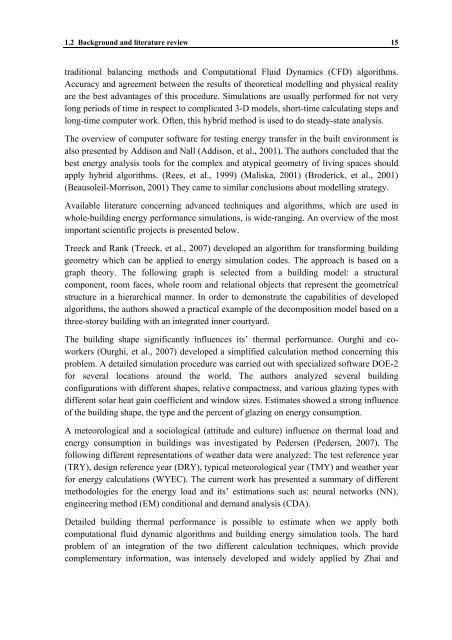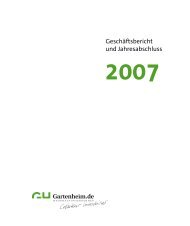analysis of the influences of solar radiation and façade glazing ...
analysis of the influences of solar radiation and façade glazing ...
analysis of the influences of solar radiation and façade glazing ...
You also want an ePaper? Increase the reach of your titles
YUMPU automatically turns print PDFs into web optimized ePapers that Google loves.
1.2 Background <strong>and</strong> literature review 15<br />
traditional balancing methods <strong>and</strong> Computational Fluid Dynamics (CFD) algorithms.<br />
Accuracy <strong>and</strong> agreement between <strong>the</strong> results <strong>of</strong> <strong>the</strong>oretical modelling <strong>and</strong> physical reality<br />
are <strong>the</strong> best advantages <strong>of</strong> this procedure. Simulations are usually performed for not very<br />
long periods <strong>of</strong> time in respect to complicated 3-D models, short-time calculating steps <strong>and</strong><br />
long-time computer work. Often, this hybrid method is used to do steady-state <strong>analysis</strong>.<br />
The overview <strong>of</strong> computer s<strong>of</strong>tware for testing energy transfer in <strong>the</strong> built environment is<br />
also presented by Addison <strong>and</strong> Nall (Addison, et al., 2001). The authors concluded that <strong>the</strong><br />
best energy <strong>analysis</strong> tools for <strong>the</strong> complex <strong>and</strong> atypical geometry <strong>of</strong> living spaces should<br />
apply hybrid algorithms. (Rees, et al., 1999) (Maliska, 2001) (Broderick, et al., 2001)<br />
(Beausoleil-Morrison, 2001) They came to similar conclusions about modelling strategy.<br />
Available literature concerning advanced techniques <strong>and</strong> algorithms, which are used in<br />
whole-building energy performance simulations, is wide-ranging. An overview <strong>of</strong> <strong>the</strong> most<br />
important scientific projects is presented below.<br />
Treeck <strong>and</strong> Rank (Treeck, et al., 2007) developed an algorithm for transforming building<br />
geometry which can be applied to energy simulation codes. The approach is based on a<br />
graph <strong>the</strong>ory. The following graph is selected from a building model: a structural<br />
component, room faces, whole room <strong>and</strong> relational objects that represent <strong>the</strong> geometrical<br />
structure in a hierarchical manner. In order to demonstrate <strong>the</strong> capabilities <strong>of</strong> developed<br />
algorithms, <strong>the</strong> authors showed a practical example <strong>of</strong> <strong>the</strong> decomposition model based on a<br />
three-storey building with an integrated inner courtyard.<br />
The building shape significantly <strong>influences</strong> its’ <strong>the</strong>rmal performance. Ourghi <strong>and</strong> coworkers<br />
(Ourghi, et al., 2007) developed a simplified calculation method concerning this<br />
problem. A detailed simulation procedure was carried out with specialized s<strong>of</strong>tware DOE-2<br />
for several locations around <strong>the</strong> world. The authors analyzed several building<br />
configurations with different shapes, relative compactness, <strong>and</strong> various <strong>glazing</strong> types with<br />
different <strong>solar</strong> heat gain coefficient <strong>and</strong> window sizes. Estimates showed a strong influence<br />
<strong>of</strong> <strong>the</strong> building shape, <strong>the</strong> type <strong>and</strong> <strong>the</strong> percent <strong>of</strong> <strong>glazing</strong> on energy consumption.<br />
A meteorological <strong>and</strong> a sociological (attitude <strong>and</strong> culture) influence on <strong>the</strong>rmal load <strong>and</strong><br />
energy consumption in buildings was investigated by Pedersen (Pedersen, 2007). The<br />
following different representations <strong>of</strong> wea<strong>the</strong>r data were analyzed: The test reference year<br />
(TRY), design reference year (DRY), typical meteorological year (TMY) <strong>and</strong> wea<strong>the</strong>r year<br />
for energy calculations (WYEC). The current work has presented a summary <strong>of</strong> different<br />
methodologies for <strong>the</strong> energy load <strong>and</strong> its’ estimations such as: neural networks (NN),<br />
engineering method (EM) conditional <strong>and</strong> dem<strong>and</strong> <strong>analysis</strong> (CDA).<br />
Detailed building <strong>the</strong>rmal performance is possible to estimate when we apply both<br />
computational fluid dynamic algorithms <strong>and</strong> building energy simulation tools. The hard<br />
problem <strong>of</strong> an integration <strong>of</strong> <strong>the</strong> two different calculation techniques, which provide<br />
complementary information, was intensely developed <strong>and</strong> widely applied by Zhai <strong>and</strong>





